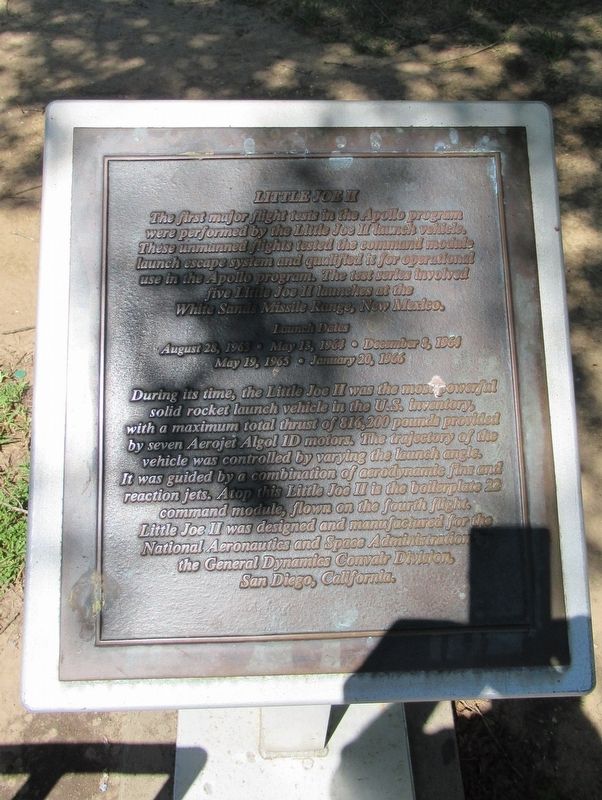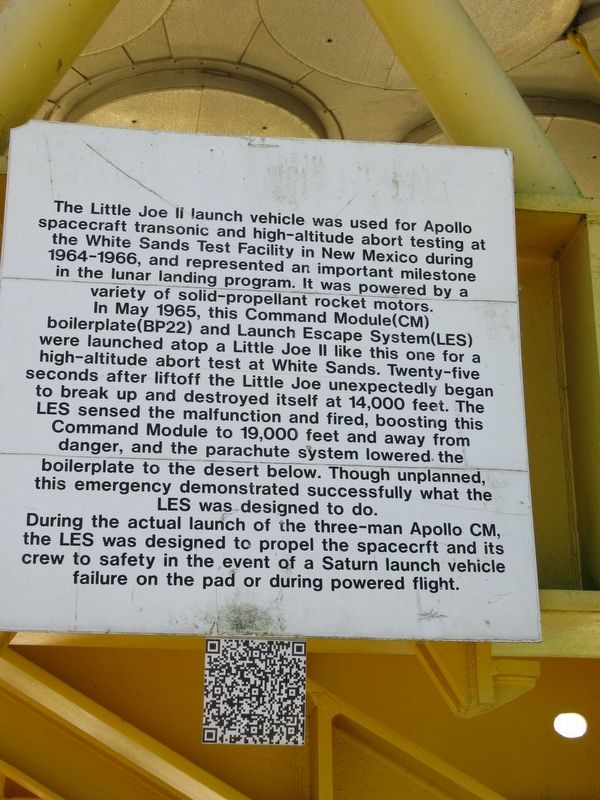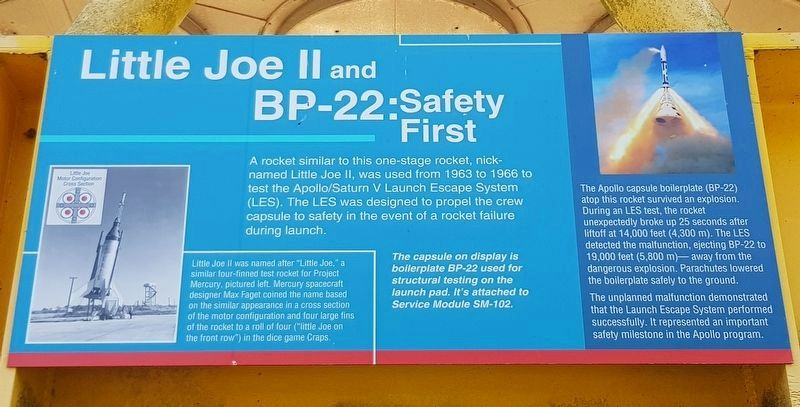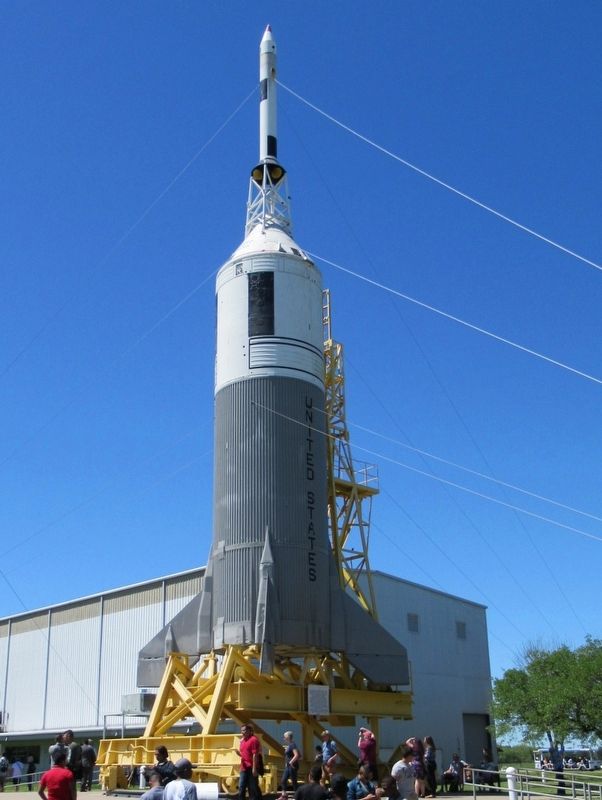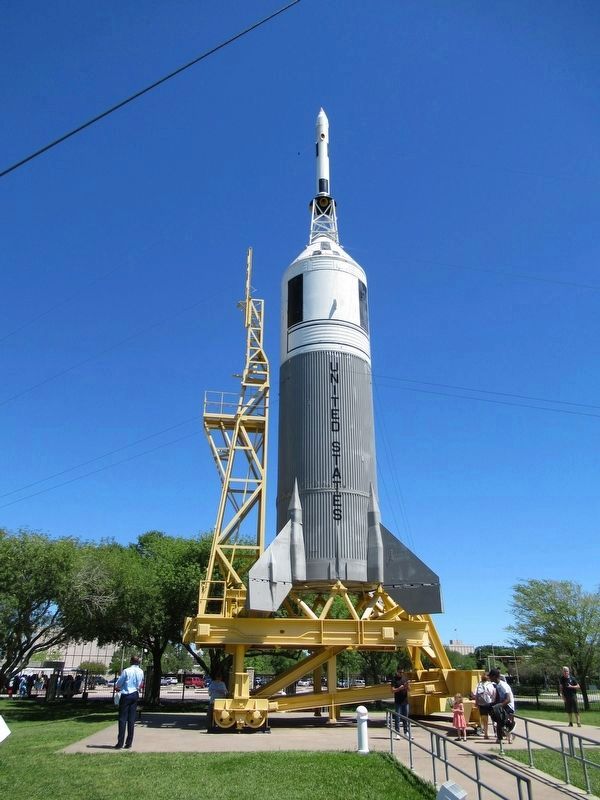Clear Lake City in Houston in Harris County, Texas — The American South (West South Central)
Little Joe II
The first major flight tests in the Apollo program were performed by the Little Joe II launch vehicle. These unmanned flights tested the command module launch escape system and qualified it for operational use in the Apollo program. The test series involved five Little Joe II launches at the White Sands Missile Range, New Mexico.
August 28, 1963 · May 13, 1964 · December 8, 1964 · May 19, 1965 · January 20, 1966
During its time, the Little Joe II was the most powerful solid rocket launch vehicle in the U.S. inventory, with a maximum total thrust of 816,200 pounds provided by seven Aerojet Algol 1D motors. The trajectory of the vehicle was controlled by varying the launch angle. It was guided by a combination of aerodynamic fins and reaction jets. Atop this Little Joe II is the boilerplate 22 command module, flown on the fourth flight. Little Joe II was designed and manufactured for the National Aeronautics and Space Administration by the General Dynamics Convair Division, San Diego, California.
( placard on the rocket stand )
The Little Joe The Little Joe II launch vehicle was used for Apollo spacecraft transonic and abort testing at White Sands Test Facility in New Mexico during 1964-1966, and represented an important milestone in the lunar landing program. It was powered by a variety of solid-propellant rocket motors.
In May 1965, this Command Module (CM) boilerplate (BP22) and Launch Escape System (LES) were launched atop a Little Joe II like this one for a high-altitude abort test at White Sands. Twenty-five seconds after liftoff the Little Joe unexpectedly began to break up and destroyed itself at 14,000 feet. The LES sensed the malfunction and fired, boosting this Command Module to 19,000 feet and away from danger, and the parachute system lowered the boilerplate to the desert below. Though unplanned, this emergency demonstrated successfully what the LES was designed to do.
During the actual launch of the three-man Apollo CM the LES was designed to propel the spacecraft and its crew to safety in the event of a Saturn launch vehicle failure on the pad or during powered flight.
Topics. This historical marker is listed in this topic list: Air & Space. A significant historical date for this entry is January 20, 1966.
Location. 29° 33.282′ N, 95° 5.618′ W. Marker is in Houston, Texas, in Harris County. It is in Clear Lake City. Marker can be reached from E. NASA Pkwy, half a mile north of Point Lookout Drive, on the right when traveling west. Located next to the Saturn Rocket Building in Johnson Space Flight Center. Touch for map. Marker is at or near this postal address: 2101 NASA Road 1, Houston TX 77058, United States of America. Touch for directions.
Other nearby markers. At least 8 other markers are within walking
distance of this marker. Little Joe II and BP-22: Safety First (here, next to this marker); Mercury-Redstone: Putting the First Americans in Space (a few steps from this marker); H-1 Engine: A Powerful Start (a few steps from this marker); F-1 Engine: Power for the Rocket (a few steps from this marker); J-2 Engine: Versatile Sidekick (within shouting distance of this marker); Saturn V Rocket (about 500 feet away, measured in a direct line); NASA Lyndon B. Johnson Space Center (about 600 feet away); Apollo Mission Control Center (approx. 0.4 miles away). Touch for a list and map of all markers in Houston.
More about this marker. This marker is in Rocket Park on the grounds of the Johnson Space Center. Rocket Park and thus this marker are not readily open to the public. Access is by way of Space Center Houston (entertainment center) which is pricey. There's a fee to get in, and another fee to take a tram ride through the Space Center where the Rocket Park is a stop.
Also see . . .
1. NASA Johnson Space Flight Center. (Submitted on April 12, 2017, by Michael Herrick of Southbury, Connecticut.)
2. Little Joe II on Wikipedia. (Submitted on April 12, 2017, by Michael Herrick of Southbury, Connecticut.)
Credits. This page was last revised on February 1, 2023. It was originally submitted on April 12, 2017, by Michael Herrick of Southbury, Connecticut. This page has been viewed 521 times since then and 40 times this year. Last updated on December 22, 2020, by Jim Evans of Houston, Texas. Photos: 1, 2. submitted on April 12, 2017, by Michael Herrick of Southbury, Connecticut. 3. submitted on October 16, 2019, by J. Makali Bruton of Accra, Ghana. 4, 5. submitted on April 12, 2017, by Michael Herrick of Southbury, Connecticut. • J. Makali Bruton was the editor who published this page.
